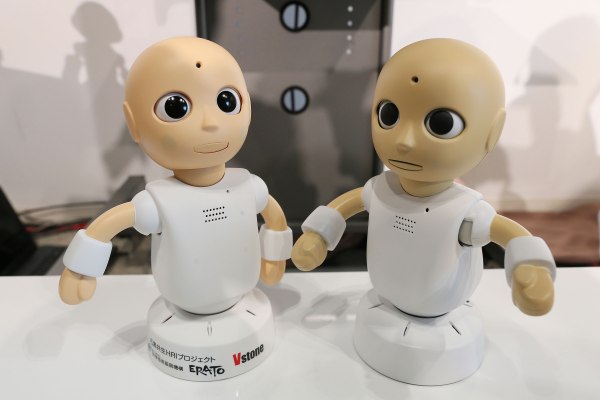We’ve all done it. Cornered at a party by some bore talking about his unimaginative app that will “change the world.” All seemingly convincing excuses to leave have already been used by the rest of the group (who were all there just a second ago). The last refuge of the rude scoundrel — the smartphone — is in your jacket pocket in the cloakroom all the way across the room. So you just have to suck it up and simulate enthusiasm for this guy’s pitch. Through a series of pre-prepared “oohs,” “aahs” and contorted eye movements, you just might get away with it.
Even those who spend a large proportion of their working lives pretending to listen (VCs being some of the most well-rehearsed) must still feel unconvincing from time to time. After all, human beings are social animals. Faking it doesn’t come naturally.
However, when you engage with a group of CommU robots for the first time — the latest creation by world-renowned Japanese roboticist, Dr. Hiroshi Ishiguro — it becomes apparent pretty darn quickly just how easy it is to feign interest in someone else’s BS.
TechCrunch caught up with Dr. Ishiguro at the Extension of Humanity event at SXSW Interactive 2016 in Austin, Texas. While he may not be a household name, anyone with even a passing interest in robotics and AI should be aware of just how much Ishiguro, the director at the Intelligent Robotics Laboratory at Osaka University in Japan, has accomplished in his field.
Ishiguro has become synonymous with the creation of eerily lifelike robots. He even designed his own android doppelgänger in 2008. Named The Geminoid, this apparent act of narcissism is but one android in a growing army of human-like robots Ishiguro has helped realize. But it would be remiss to overlook his work as little more than a vanity project getting out of hand. The key to Ishiguro’s talent for robotics has always been the centrality he places on human psychology within robotics engineering.
AI isn’t just about programming and engineering skills. Dr. Hiroshi Ishiguro
“AI isn’t just about programming and engineering skills,” he says. “Equally important for roboticists is an understanding of human psychology and behavior, not just clever math and novel design applications. One must find a balance between the psychological and the scientific when building androids.”
For Ishiguro, understanding cognitive science and psychology greatly improves any engineer’s ability to turn an artificial android into a convincing lifelike replica.
The disingenu-bot
Ishiguro was in the Lone Star State to promote a number of his products and prototypes, including a small, rather unimpressive-looking robot named the CommU (short for Communication Unity).
This isn’t one of Ishiguro’s most advanced AI prototypes, but the CommU’s relatively simple design demonstrates a key aspect of the modern human condition: group dynamics. In doing so, however, Ishiguro has also inadvertently shown how easy it is to pretend to listen.
In its simplest terms, the CommU, which looks like a creepy baby, is 11 inches in height, and ideally come in pairs of two or more. Ishiguro is quick to point out that the bigger the group, the more realistic the communication exchange. The robots are programmed to “talk” to each other on a number of topics; when observing from afar, there does appear to be a real conversation taking place. When the group senses the presence of a human, they are programmed to engage with them and involve them in their exchange.
“If you have two or more robots having a conversation with each other and suddenly a human joins the group, the CommU will recognize the human is talking and say something along the lines of: ‘What do you think?’” he says. “When you answer, the robots will say, ‘I see’ or ‘Interesting,’ then return to their own ‘conversation.’ They don’t understand what the human is saying. The CommU simply demonstrates the dynamics of group communication.”
But with two or more, a convincing communication exchange in a group setting happens — even though the robots cannot understand the human.
In a previous interview, Ishiguro claims the idea for CommU was, in part, inspired by watching groups of children interacting. If an adult joins a group of kids in conversation, he doesn’t expect much by way of stimulating exchange: He engages with the children for fun.
Aside from the various verbal prompts used by the CommU to realistically engage with a human, Ishiguro also included some key body language characteristics, important in making any conversation feel real, such as rolling eyeballs.
However, there couldn’t be a convincing exchange between one CommU and a human. “The robot would need voice recognition technology for that to work,” stresses Ishiguro. It is in the pre-programmed interplay between these robots in a group that makes the technology so interesting. Hence the need to purchase them in pairs or groups of three or four. Starting at $850 per robot, though, it might be cheaper just to RSVP the next networking event in your neighborhood and plan to tell everyone in attendance about your college thesis.
